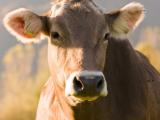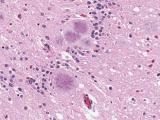Apr 24, 2008 (CIDRAP News) The US Food and Drug Administration (FDA) yesterday announced a ban on certain cattle materials from all animal feed starting next year, an action designed to protect animals and humans against bovine spongiform encephalopathy (BSE), or mad cow disease.
Materials barred from animal feed are those most likely to contain the BSE agent, the FDA said in a press release. Known as "specified risk materials," the tissues include the brains and spinal cords of cattle aged 30 months or older.
The new rule also prohibits cattle carcasses that haven't been inspected and cleared for human consumption unless the brains and spinal cords have been removed or the cattle are less than 30 months old. Animal health experts have said the risk of BSE in cattle younger than 30 months is exceedingly low.
To give the affected industries time to adapt, the new rule will not take effect until Apr 23, 2009, the FDA said.
Bernadette Dunham, director of the FDA's Center for Veterinary Medicine, said in the press release that the FDA's action further protects US cattle from an already low risk of BSE. "The new rule strengthens existing safeguards," she said.
The FDA said the rule was first proposed and opened for public comment in October 2005.
Canada has had a similar ban on SRM in all animal feed since July 2007; however, the Canadian rule goes a step further by banning the risky parts from use in fertilizer.
To prevent the spread of BSE, the United States and Canada both banned the use of cattle protein in feed for cattle and other ruminant animals in 1997. The new rule builds on the 1997 regulation, the FDA said.
After Canada and the United States each discovered its first BSE case in 2003, both countries banned the use of SRM from cattle older than 30 months in human food. Proposals to ban SRM from all animal feed and pet food grew out of concerns that the BSE agent could spread if feed intended for nonruminant animals, such as pigs, poultry, or pets, cross-contaminated cattle feed during production or transport or was accidentally given to cattle on farms.
When Canada banned SRM from all animal feeds last year, the restrictions created difficulties for the country's cattle industry, according to previous reports. The SRM had to be removed with special equipment and disposed of with specialized procedures.
The FDA said the new rule could cost the US beef industry $100 million in the first year and about $80 million annually in following years, the Washington Post reported today.
However, the new restrictions could also benefit the industry. A US official told the Post that South Korea lifted restrictions on US beef last week after receiving assurances that the United States would strengthen its feed rules.
Ron Eustice, executive director of the Minnesota Beef Council, based in Minneapolis, told CIDRAP News he supported the FDA's stronger feed ban. "We have always had concerns about the remote possibility of cross-species utilization of feedstuffs," he said. "This step is taken in an abundance of caution to continue our efforts to safeguard America's beef supply."
The United States has found three BSE cases, the last one in March 2006. Canada has discovered a total of 12, the last one in late February.
In other developments, the Canadian Food Inspection Agency (CFIA) announced in a press release on Apr 16 that the country's 11th BSE case, in a 13-year-old beef cow from Alberta, had an atypical strain of BSE that has also been reported in Europe. Officials said the atypical strain is more common in older cattle and has been found in only one other Canadian BSE case.
See also:
Apr 23 FDA press release
Jul 13, 2007, CIDRAP News story "Canada widens BSE-related feed ban; US still pondering"
Sep 22, 2005, CIDRAP News story "FDA to add new BSE-related feed rules soon"
















